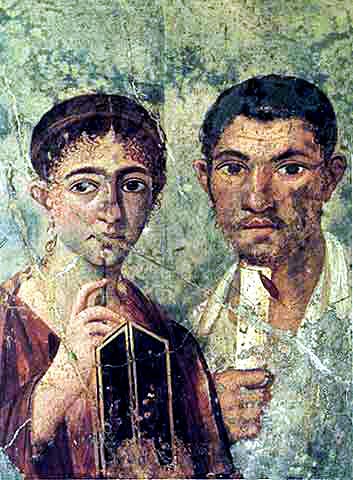 |
This is a file from the Wikimedia Commons. Information from its description page there is shown below.
Commons is a freely licensed media file repository. You can help.
|
| Artist |
Unknown |
| Title |
Italiano: Museo Archeologico Nazionale di Napoli (inv. nr. 9058). Da Pompeii, Casa di Terentius Neo (VII, 2, 6) - A lungo erroneamente considerato il ritratto di Paquio Proculo e di sua moglie, in realtà l'affresco ritrae il panettiere Terentius Neo con la moglie. I due personaggi, di origini umili, saliti nella scala sociale, si mostrano lui come un letterato (tiene in mano un rotolo di papiro), mentre lei tiene una tavoletta cerata (dunque si cura della contabilità della panetteria e della casa).
English: Pompeii, House VII, 2, 6: Identity disputed. .
Italiano: Ritratto di Paquio Proculo e di sua moglie. Dalla casa VII, 2, 6 di Pompei.
|
| Date |
English: 1st century
Italiano: del 20/30 d.C.
|
| Medium |
English: fresco
Italiano: Affresco romano staccato, del secondo stile
|
| Current location |
English: Exhibited in the National Archaeological Museum of Naples in Naples.
Italiano: oggi conservato al Museo archeologico nazionale di Napoli
|
|
|
| Notes |
Upload to English wikipedia by Eloquence, 16.11.2002. |
| Source/Photographer |
Unknown |
Permission
( Reusing this file) |
This is a faithful photographic reproduction of an original two-dimensional work of art. The work of art itself is in the public domain for the following reason:
| Public domainPublic domainfalsefalse |
 |
This work is in the public domain in the United States, and those countries with a copyright term of life of the author plus 100 years or less. |
|
This file has been identified as being free of known restrictions under copyright law, including all related and neighboring rights.
|
The official position taken by the Wikimedia Foundation is that "faithful reproductions of two-dimensional public domain works of art are public domain, and that claims to the contrary represent an assault on the very concept of a public domain". For details, see Commons:When to use the PD-Art tag.
This photographic reproduction is therefore also considered to be in the public domain. Please be aware that depending on local laws, re-use of this content may be prohibited or restricted in your jurisdiction. See Commons:Reuse of PD-Art photographs.
|
|
Licensing
This is a faithful photographic reproduction of an original two-dimensional work of art. The work of art itself is in the public domain for the following reason:
| Public domainPublic domainfalsefalse |
 |
This work is in the public domain in the United States, and those countries with a copyright term of life of the author plus 100 years or less. |
|
This file has been identified as being free of known restrictions under copyright law, including all related and neighboring rights.
|
The official position taken by the Wikimedia Foundation is that "faithful reproductions of two-dimensional public domain works of art are public domain, and that claims to the contrary represent an assault on the very concept of a public domain". For details, see Commons:When to use the PD-Art tag.
This photographic reproduction is therefore also considered to be in the public domain. Please be aware that depending on local laws, re-use of this content may be prohibited or restricted in your jurisdiction. See Commons:Reuse of PD-Art photographs.
|
- ↑ Clarke, John R. (2006) Visual Representation and Non-Elite Viewers in Italy, 100 B.C.-A.D. 315, University of California, p. 262-264 ISBN: 9780520248151.
File usage
The following pages on Schools Wikipedia link to this image (list may be incomplete):
SOS Children's Villages chose the best bits of Wikipedia to help you learn. SOS Children is an international children's charity, providing a good home and loving family to thousands of children who have lost their parents. We also work with communities to help vulnerable families stay together and raise children in the best possible environment. Try to find out how you can help children in other countries on our web site.



